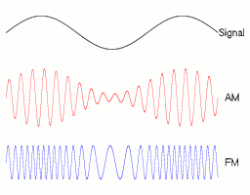History of radio § Broadcasting, and History of broadcasting
The
early history of radio is the history of technology that produces and
uses radio instruments that use radio waves. Within the timeline of radio, many people contributed
theory and inventions in what became radio. Radio development began as "wireless telegraphy".[1] Later radio history increasingly involves matters
of broadcasting.
The
idea of wireless communication predates the discovery of "radio" with
experiments in "wireless telegraphy" via inductive and capacitive induction and
transmission through the ground, water, and even train tracks from the 1830s on. James Clerk Maxwell showed in theoretical and mathematical form in 1864
that electromagnetic waves could propagate through free space. It
is likely that the first intentional transmission of a signal by means of
electromagnetic waves was performed in an experiment by David Edward Hughes around 1880, although this
was considered to be induction at the time. In 1888 Heinrich Rudolf Hertz was able to conclusively prove transmitted airborne
electromagnetic waves in an experiment confirming Maxwell's theory of electromagnetism.
The
meaning and usage of the word "radio" has developed in parallel with
developments within the field of communications and can be seen to have three
distinct phases: electromagnetic waves and experimentation; wireless
communication and technical development; and radio broadcasting and
commercialization. In an 1864 presentation, published in 1865, James Clerk Maxwell proposed theories of electromagnetism, with mathematical proofs, that showed that light and
predicted that radio and x-rays were all types of electromagnetic waves
propagating through free space. In 1886–88 Heinrich Rudolf Hertz conducted a series of experiments that proved the
existence of Maxwell's electromagnetic waves, using a frequency in what would
later be called the radio spectrum. Many individuals—inventors, engineers, developers and
businessmen—constructed systems based on their own understanding of these and
other phenomena, some predating Maxwell and Hertz's discoveries. Thus
"wireless telegraphy" and radio wave-based systems can be attributed
to multiple "inventors". Development from a laboratory demonstration
to a commercial entity spanned several decades and required the efforts of many
practitioners.
Extensions
of traditional radio-wave broadcasting for audio broadcasting in general include cable radio, local wire television networks, DTV radio, satellite radio, and internet radio via streaming media on the Internet.
Broadcasting by radio takes several forms.
These include AM and FM stations. There are
several subtypes, namely commercial
broadcasting, non-commercial educational (NCE) public
broadcasting and non-profit varieties
as well as community
radio, student-run campus radio stations,
and hospital
radio stations can be found throughout the world. Many stations
broadcast on shortwave bands
using AM technology that can be received over thousands of miles (especially at
night). For example, the BBC, VOA, VOR, and Deutsche Welle have
transmitted via shortwave to Africa and Asia. These broadcasts are very
sensitive to atmospheric conditions and solar activity.
Nielsen
Audio, formerly known as Arbitron, the United States-based company
that reports on radio audiences, defines a "radio station" as a
government-licensed AM or FM station; an HD Radio (primary or multicast)
station; an internet stream of an existing government-licensed station; one of
the satellite radio channels from XM
Satellite Radio or Sirius
Satellite Radio; or, potentially, a station that is not government
licensed.
AM broadcasting is a radio broadcasting technology, which employs amplitude modulation (AM) transmissions. It was the first method developed
for making audio radio transmissions, and is still used worldwide, primarily
for medium wave (also known as "AM band") transmissions, but
also on the long wave and shortwave radio bands.
The earliest experimental AM transmissions began
in the early 1900s. However, widespread AM broadcasting was not established
until the 1920s, following the development of vacuum tube receivers
and transmitters. AM radio remained the dominant method of broadcasting for the
next 30 years, a period called the "Golden
Age of Radio", until television broadcasting became widespread
in the 1950s and received most of the programming previously carried by radio.
Subsequently, AM radio's audiences have also greatly shrunk due to competition
from FM (frequency
modulation) radio, Digital Audio Broadcasting (DAB), satellite radio, HD (digital) radio and
Internet streaming.
AM transmissions are much more susceptible than FM or
digital signals are to interference, and often have lower audio fidelity. Thus,
AM broadcasters tend to specialize in spoken-word formats, such as talk radio, all news and sports, leaving the
broadcasting of music mainly to FM and digital stations.






Comments
Post a Comment